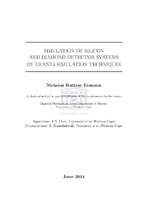| dc.contributor.advisor | Orce, J.N. | |
| dc.contributor.advisor | Halindintwali, S | |
| dc.contributor.author | Erasmus, Nicholas Rattray | |
| dc.date.accessioned | 2014-11-24T09:48:25Z | |
| dc.date.available | 2014-11-24T09:48:25Z | |
| dc.date.issued | 2014 | |
| dc.identifier.uri | http://hdl.handle.net/11394/3914 | |
| dc.description | >Magister Scientiae - MSc | en_US |
| dc.description.abstract | There is a constant need for improvement in nuclear particle detection methods. Silicon surface barrier detectors have proved very valuable during the last decades. Diamond is a viable alternative to silicon as a semiconductor detector. It offers significant advantages over silicon due to its high radiation hardness and low drift currents.
A Coulomb-excitation study has been carried out at TRIUMF using a 59.7 MeV 12C beam impinging on a 194Pt target. The particles underwent elastic Rutherford scattering in the target, and a double sided silicon S3 CD detector was used to measure the resulting particle energy spectra. These spectra were simulated in GEANT4 and compared to the experimental results. Subsequently, the silicon was replaced with diamond and the simulation was repeated. Such simulations of particle energy spectra, properly incorporating elastic Rutherford scattering, have not been carried out with GEANT4 before. An accurate simulation of the elastic peak obtained from particle spectra will provide a methodology for applying particle-gamma coincidence techniques. The study of the inelastic peak in 12C and similar nuclei will benefit from such developments. Such simulations will also offer high energy calibration points for the experimental data, and the possibility of testing the experimental conditions including the target thickness, beam energy, and linearity of electronic modules (e.g. the preamplifier). The simulation offered results comparable to the experimental case. GEANT4 was found to simulate the Rutherford cross sections at specific scattering angles as well as the position of the simulated energy peaks accurately when compared with the experimental case. As expected, the experimentally obtained particle energy spectra displayed more broadening than the simulated spectra, though the shape of the peaks was very similar. The simulation of the double sided diamond detector was a tentative first step in its testing as a particle detector. The sophisticated methods required to properly simulate and test diamond for nuclear physics experiments were not implemented. This simulation may serve as a starting point for further testing of diamond detectors, using advanced simulation techniques | en_US |
| dc.language.iso | en | en_US |
| dc.publisher | University of the Western Cape | en_US |
| dc.title | Simulation of silicon and diamond detector systems by GEANT4 simulation techniques | en_US |
| dc.type | Thesis | en_US |
| dc.rights.holder | University of the Western Cape | en_US |

